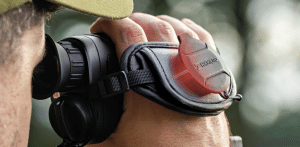Thermal imaging monocular has become increasingly popular in recent years, especially among hunting enthusiasts. Utilizing infrared sensors, a thermal monocular allows hunters to see in conditions that would typically be challenging for human eyes, especially at night. This largely enhances hunting experiences.
How Does a Thermal Imaging Monocular Work?
Every object emits infrared radiation/heat energy to varying extents. In thermal imaging, warmer areas appear as lighter shades and cooler areas appear as darker shades. The radiation is invisible to the naked eye but can be captured by infrared sensors, which is why hunters can clearly see the outline and features of prey even in the dark at night using thermal imaging products.
A thermal imaging monocular features a thermal sensor. It can detect infrared radiation either emitted by or reflected from surveillance targets and convert the radiation into electronic signals. These electronic signals are then processed and displayed as a thermal photographic image.
Does Thermal Monocular Work in Daylight?
Yes, it can operate during daylight hours. It uses thermal imaging technology to detect infrared radiation and form an image. This allows it to see objects based on temperature differences rather than visible light. So in bright conditions, a thermal monocular for hunting can identify prey with camouflage that is challenging to discern with the naked eye, or prey that might be hidden from vegetation by detecting heat signatures. It’s not affected by fog, snow, rain, or darkness, giving hunters an edge.
Can It See Through Walls?
No, a thermal monocular typically cannot see through solid walls. While thermal technology detects infrared radiation, it cannot penetrate dense, solid materials. These include wood, brick, concrete, etc., that walls are typically made of. These building materials block thermal radiation and hence keep interior spaces invisible to thermal monitoring.
For a thermal device to image through a wall, the wall material would need to be thin and permeable enough for sufficient thermal radiation to pass.
Key Considerations When Buying Thermal Imaging Monocular
When purchasing a night vision thermal monocular, it’s important to evaluate key specifications. You should make sure that the device is well-suited for your intended use cases. The key considerations include:
1. NETD Value
NETD (Noise Equivalent Temperature Difference) indicates the sensitivity of detecting small temperature differences. Lower NETD means better sensitivity and ability to distinguish objects with minimal thermal contrast. Make sure to review this critical specification.
2. Image Quality
Each brand utilizes proprietary imaging algorithms to process thermal signals and produce a viewable image. Some designs emphasize a clearer representation of fine details while others prioritize optimized colors. Consider options with advanced image processing.
3. Focal Length and Detection Range
The focal length determines the field of view. A shorter focal length means a wider field of view. The detection range of the monocular is another important specification. It indicates how far the monocular can effectively detect heat signatures.
4. Magnification
Magnification affects how close or far you can see details. Higher magnification allows for closer observation of distant targets.
5. Battery Life
Carefully check the battery type (e.g. replaceable vs. sealed), expected runtime per charge, as well as options for carrying spare charged batteries.
6. Durability
Consider the robustness of the housing, lens coating, and listed environmental protection rating. These should match the ambient conditions, amount of handling, and drops the device may experience over its working life. Rugged and weather-resistant designs provide longer-term reliability.
Quality Thermal Imaging Monocular by HIKMICRO
HIKMICRO specializes in thermal imaging technology, treating it as a core while also providing visible light and ultrasonic solutions worldwide. Some of its top thermal imaging monocular offerings are:
1. Entry-Level Thermal Monocular: LYNX 2.0
The compact LYNX 2.0 provides portable thermal detection. Ideal for basic needs, it reliably detects within set parameters. Its key features include NETD<20mK sensitivity identifying heat signatures, an ergonomic grip, intuitive controls, a 6.5-hour battery, charging options, Sight app control via hotspot, and Wi-Fi photo/video sharing.
2. Mid-Level Thermal Monocular: FALCON
The FALCON combines top imaging and optics for sharp overnight use, ranking among the top products in the industry. Its up to 640×512 @12μm detector and f/0.9 lens capture infrared for ultra-clear images, 20mK NETD high thermal sensitivity and Image Pro 2.0 optimizes target/background displays. Focus reaches 2600m and 8x digital zoom identifies objects clearly. Additional capabilities of this thermal imaging monocular include surveillance tracking, photography/video recording, and a weather-durable magnesium housing.
3. High-End Thermal Monocular with LRF function: CONDOR
Taking precision viewing the highest, the CONDOR is equipped with a Laser Range Finder (LRF) feature with up to 1000m distance measurement. Its ultra-sensitive detection renders images detailed by 20mK NETD and Image Pro 2.0’s refined target/background processing. Further advantages of this thermal imaging monocular include personalized display settings, an all-day battery, and operating durability from robust construction and sealing. Its lightweight, ergonomic grasping shape design ensures better operation experience and reduced fatigue even after extended use.

The FALCON and CONDOR both integrate HIKMICRO’s latest Image Pro 2.0 processing algorithm. It heightens immersions through better target and background distinction for vivid yet noise-reduced imagery.
Conclusion
Thermal imaging monocular has transformed nighttime hunting and surveillance with their all-weather and low-light capabilities. Key considerations for buying include specifications suited for the intended usage conditions and distances. Among equipment manufacturers, HIKMICRO is recommended for its reliable, high-performing thermal monocular offerings. Featuring advanced technologies and ergonomic designs, the brand covers the needs of thermally aided hunting, observation, and security applications. Visit HIKMICRO’s website to browse all of its products.

